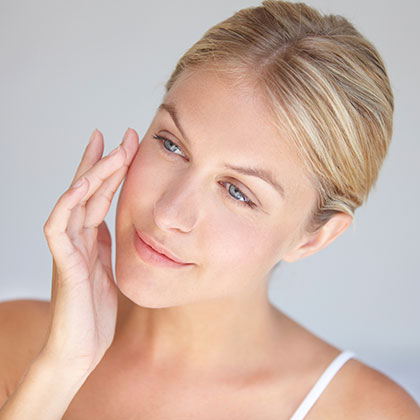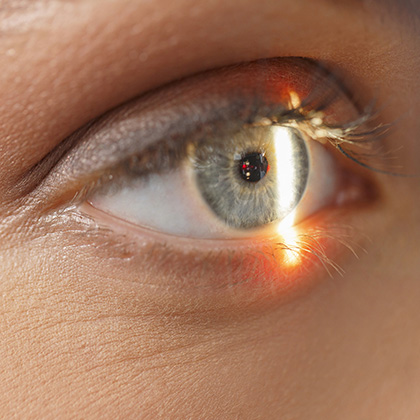Glaucoma is the name for a group of eye conditions that can cause loss of vision if left untreated. It causes damage to the optic nerve at the back of your eye, the nerve that carries signals from the back of your eye to your brain.
Here, in a nutshell, is how your vision works.
-
Light from an object or scene that you’re looking at passes through the front of your eye, through the lens and onto the retina.
-
The retina is made up of light-sensitive tissue containing cells called rods and cones, which convert light into electrical signals. These then travel across a network of nerves leading to the optic nerve.
-
When your brain receives these signals from the optic nerve, it interprets them in the form of an image.
Increased eye pressure
The optic nerve can become damaged by raised pressure in the eye (called ocular hypertension, this isn’t the same as high blood pressure). The eye needs a certain amount of pressure removed to keep its shape and work properly. This pressure is provided by a clear jelly-like substance called vitreous humour, which fills the part of the eye behind the lens (the posterior chamber).
The front part of your eye (the anterior chamber) is filled with a clear watery fluid called aqueous humour. This fluid is produced on a continuous basis by cells in the ciliary body of your eye, which is at the base of the back of the iris in the posterior chamber.
However, when the aqueous humour doesn’t drain away properly, the pressure in the eye can increase. Normally the fluid passes through the centre of the iris into the anterior chamber, where it drains into the blood stream via a sieve-like area called the trabecular meshwork.
But the trabecular meshwork – which consists of tiny drainage channels – can become partially blocked, which stops the aqueous humour draining away properly. And when that happens, there’s a build-up of pressure in the eye.
It’s not clear what causes this blockage. But when it happens, the increased pressure in the eye damages the nerve fibres that run from the retina at the point where they meet the optic nerve. This damage causes blind spots or permanent patches of vision loss that usually starts in the corners of your field of vision. And in some cases, it can lead to severe sight impairment (total loss of vision).
Types of glaucoma
While increased pressure in the eye (intraocular pressure or IOP) is thought to be the main cause of glaucoma, some people are affected by the condition even when their IOP is within the normal range. According to the charity RNIB, in these cases glaucoma may be caused by a weakness in the optic nerve(i).
Indeed, there are several different types of glaucoma:
Primary open angle glaucoma
This is the most common type of glaucoma. This type of glaucoma develops very slowly. Sometimes this is also called simple open-angle glaucoma or chronic open-angle glaucoma.
Acute angle closure glaucoma
This type of glaucoma isn’t common but it’s very serious because it makes the pressure inside the eye rise quickly. Caused by a sudden blockage of the drainage in the eye, it usually causes sudden severe eye pain along with other symptoms.
Secondary glaucoma
If you develop glaucoma as a result of an underlying eye conditions – such as uveitis (inflammation of the eye) – it’s called secondary glaucoma. Other things that may cause secondary glaucoma include eye surgery, injuries and certain medications.
Normal tension glaucoma
This type of glaucoma – also called normal pressure glaucoma – isn’t caused by increased IOP, since in these cases the pressure inside the eye is normal (experts believe between a third to a half of eyes with glaucoma have normal IOP (ii)).
Congenital glaucoma
Also called childhood or developmental glaucoma, this too is rare. Caused by an abnormality of the eye, it usually affects newborn babies and very young children. It can be very serious.
Are you at risk?
Glaucoma is most common in older people, typically those in their 70s and 80s (iii). But it can affect you at any age. And since it doesn’t have any symptoms in the early stages, experts believe many people have it without realising it (iii).
Age is considered the most usual risk factor, since most people are diagnosed with the most common type of glaucoma after the age of 60 (iv). According to Moorfields Eye Hospital, around 480,000 people in England have primary open angle glaucoma (v). Among white Europeans, about one in 50 people over 40 years of age and one in 10 people over 75 years of age have primary open-angle glaucoma. Other age-related conditions that affect your eyes as you age include age-related macular degeneration and cataracts.
Experts also claim the risk of developing primary open angle glaucoma is higher if you’re of black-African or black-Caribbean origin, while the risk of acute angle closure is higher in those of Asian origin compared with those from other ethnic groups (v).
Other things that may increase your risk for developing glaucoma include the following:
Family history
Increased intraocular pressure (IOP), the main cause of glaucoma, is thought to run in families, and experts believe you may be more likely to develop glaucoma if you have a parent or sibling with the condition (iii). According to the Glaucoma Research Foundation, family history increases your risk of glaucoma four to nine times (vi).
Medical conditions
While increased IOP isn’t the same as high blood pressure, having high blood pressure may contribute to a higher-than-normal risk of glaucoma. Having diabetes is also believed to be a risk factor, as are retinal conditions such as retinal detachment, retinitis pigmentosa and central retinal vein occlusion. It’s also thought that being very short sighted (myopia) may predispose you to glaucoma(vii).
Glaucoma and driving
Despite the fact that glaucoma is the second leading cause of blindness in the world (viii), most people who are treated for it in the UK retain useful vision for life, says the International Glaucoma Association (ix) – though any initial patches of vision loss caused by the condition will be permanent. This may affect your ability to do things such as driving.
Many of those diagnosed with glaucoma are still capable of – and allowed to – drive. It all depends on how much your vision has been affected. According to the International Glaucoma Association, the DVLA says that to be medically fit to drive a vehicle, you must have both good central vision and adequate peripheral vision (x).
-
If you’ve been diagnosed with glaucoma in one eye and the other eye still has a normal field of vision, you don’t have to inform the DVLA about your condition (though it’s important to have a special test to assess any possible damage to your peripheral vision before continuing to drive).
-
If you drive a Group Two vehicle (heavy goods vehicles and passenger-carrying vehicles), you must inform the DVLA, even if you only have glaucoma in one eye.
-
If you have glaucoma in both eyes, you must inform the DVLA. This means you may have regular tests to check it’s safe for you to drive.
Note: you can be fined up to £1,000 if you don’t tell the DVLA about a medical condition that affects your driving (xi).
Glaucoma treatments
The conventional treatment for glaucoma depends on which type of the condition affects you.
Eye drops
This is the main treatment for people with primary open angle glaucoma. There are four main types of eye drops, all of which work by reducing the pressure in your eyes (some reduce the amount of aqueous humour your eyes produce while others help to increase the drainage of aqueous humour).
Some eye drops, however, aren’t suitable for some people – those with asthma or a heart condition, for instance – plus they can also cause side effects. Some people may also need more than one type of eye drop to keep their eye pressure low.
Depending on the cause, secondary glaucoma may also be treated with eye drops.
Laser treatment
If using eye drops doesn’t reduce the pressure in your eyes to a low enough level, you may be advised to have laser treatment. With this type of laser treatment, the laser stops fluid building up inside the eyes. There are three main types of treatment:
-
Improving the drainage of aqueous humour by making tiny holes in the drainage channels in the eye (the trabecular meshwork) – this is known as laser trabeculoplasty.
-
Using a laser to destroy parts of the ciliary body – which produces aqueous humour in the eye – to reduce the amount of aqueous humour in the eye (cyclodiode laser treatment).
-
Improving the drainage of aqueous humour by making tiny holes in the iris (laser iridotomy).
Laser treatment is often used for those with primary open angle glaucoma and secondary glaucoma. People with primary angle closure glaucoma often need immediate hospital treatment with medication to lower the pressure in their eyes, after which they too may have laser treatment.
Eye surgery
Operations such as a trabeculectomy – which allows the aqueous humour to drain more easily by letting it bypass blocked drainage channels – are sometimes recommended as an alternative to laser treatment. You may be advised to have one of these operations if you have primary open angle glaucoma or secondary glaucoma.
Children and babies with glaucoma (congenital glaucoma) may also need surgery to correct the abnormality in the eye that has caused increased intraocular pressure.
Natural ways to keep your vision healthy
Glaucoma can usually be detected during a routine eye test, often before it causes any symptoms. So it’s particularly important to go for regular eye tests, especially if you’re aged 40 or older or if you have a higher-than-normal risk of developing the condition (if one of your parents, children or a brother or sister has glaucoma, you can get free NHS eye tests if you’re over 40).
Meanwhile, there may not be a way of preventing glaucoma. But there are things you can do to keep your vision as healthy as possible. To understand more why not view our guide to living with glaucoma, to learn more about how to manage your condition.
Stay active
According to experts from the Mayo Clinic in the US, regular moderate exercise may help keep the pressure in your eyes at a normal level (xii). Aim for at least 150 minutes of moderate-intensity exercise each week (moderate intensity means you’re working hard enough to raise your heart rate and feel warm).
Eat healthily
Many natural health practitioners recommend a diet rich in antioxidants to keep the eyes healthy. Getting plenty of fruit and veg – at least five portions a day (preferably more) – can go some way to making sure your diet is antioxidant rich.
Choose produce that’s richly coloured, such as papayas, peppers, sweet potatoes, beetroot, citrus fruits and dark leafy greens such as spinach and kale for an antioxidant boost. Other foods such as seafood, nuts, avocados and eggs contain vitamin E, which is also an antioxidant.
Antioxidants called lutein and zeaxanthin are thought to be of particular benefit where eye health is concerned. These are found in a variety of foods, including kale, spinach, broccoli, pumpkin, Brussels sprouts, corn, egg yolks and green beans. Another potent antioxidant related to lutein and zeaxanthin, called astaxanthin, may also help with vision health. This is derived from a freshwater algae, and is the pigment that gives some fish and shellfish such as salmon and lobster their distinctive red/pink colour. You can get more astaxanthin in your diet by eating foods such as salmon, lobster, shrimp, crawfish and crab.
You can also take lutein, zeaxanthin and astaxanthin in supplement form (many eye health multivitamin and mineral supplements contain lutein and/or zeaxanthin, as well as other antioxidants such as vitamin A, C and zinc; while astaxanthin is usually found as a single-nutrient supplement – read more about astaxanthin and its many benefits for eye health here.
Dark and richly-coloured fruits – such as blackberries, blueberries, raspberries and red or black grapes – are also thought to be important for eye health. This may be because they contain substances called anthocyanidins, which are also powerful antioxidants (anthocyanidins belong to the flavonoids family of plant chemicals). Anthocyanidins are thought to boost eye health because they strengthen and protect the capillary walls in the eyes.
The omega-3 fatty acids found in oily fish such as salmon, fresh tuna, herring, trout and sardines are also thought to protect the eyes, with studies suggesting they may help reduce intraocular pressure (xiii). A good-quality fish oil supplement may be ideal for those who don’t eat enough oily fish (the NHS currently recommends that a healthy diet should include at least two 140g portions of fish a week, one of which should be oily fish (xiv).
Meanwhile, if you are a vegetarian or vegan you can still benefit from an omega-3 supplement, thanks to the availability of products that contain the natural triglyceride (TG) form of omega-3, which is sourced from plant organisms called microalgae rather than fish.
To understand more why not read our guide on glaucoma and diet.
Herbal help for glaucoma
There is some evidence that the herb ginkgo biloba may be useful for those who already have glaucoma.
Ginkgo is thought to be the oldest surviving species of tree. It is used today by herbal practitioners for a range of health problems and is thought to work by boosting circulation. One small-scale study also suggests a daily 120mg dose of ginkgo for eight weeks may improve vision in glaucoma cases (xv). Another report claims it may ‘probably’ be useful for all glaucoma patients, including those who have normal tension glaucoma (glaucoma that isn’t related to increased intraocular pressure) (xvi). More recently, researchers writing in the journal Current Opinion in Ophthalmology says that while published data are limited, ginkgo is potentially effective in treating glaucoma (xvii).
For more information on how to keep your eyes healthy as you age, feel free to visit our dedicated eye health hub. Or to discover more articles on a range of other common health conditions, our health library is a good place to start.
References:
-
Available online: https://www.rnib.org.uk/eye-health/eye-conditions/glaucoma
-
Anderson. DR., Normal-tension glaucoma (Low-tension glaucoma). Indian J Ophthalmol. 2011 Jan;59 (Suppl1):S97-S101.Available online: https://www.ncbi.nlm.nih.gov/pmc/articles/PMC3038511/
-
Available online: https://www.nhs.uk/conditions/glaucoma/
-
Available online: https://patient.info/eye-care/acute-angle-closure-glaucoma/chronic-open-angle-glaucoma
-
Available online: https://www.moorfields.nhs.uk/condition/glaucoma
-
Available online: https://www.glaucoma.org/glaucoma/are-you-at-risk-for-glaucoma.php
-
Chen. SJ et al., High myopia as a risk factor in primary open angle glaucoma. Int J Ophthalmol. 2012;5(6):750-753.Available online: https://www.ncbi.nlm.nih.gov/pmc/articles/PMC3530820/
-
Available online: https://www.who.int/bulletin/volumes/82/11/feature1104/en/
-
Available online: https://www.glaucoma-association.com/about-glaucoma/living-with-glaucoma/
-
Available online: https://www.glaucoma-association.com/about-glaucoma/living-with-glaucoma/driving-and-glaucoma
-
Available online: https://www.gov.uk/glaucoma-and-driving
-
Available online: https://www.mayoclinic.org/diseases-conditions/glaucoma/symptoms-causes/syc-20372839
-
McGuire. R. Fish oil cuts lower ocular pressure. Med Tribune. 1991;19:25.
-
Downie. LE, Vingrys AJ., Oral Omega-3 Supplementation Lowers Intraocular Pressure in Normotensive Adults. Transl Vis Sci Technol. 2018 May 1;7(3):1. Available online: https://www.ncbi.nlm.nih.gov/pubmed/29736322
-
Available online: https://www.nhs.uk/live-well/eat-well/fish-and-shellfish-nutrition/
-
Quaranta. L, Bettelli. S, Uva. MG, et al. Effect of Ginkgo biloba extract on preexisting visual field damage in normal tension glaucoma. Ophthalmology. 2003;110:359-362.
-
Cybulska-Heinrich. AK, Mozaffarieh. M, Flammer. J. Ginkgo biloba: An adjuvant therapy for progressive normal and high tension glaucoma. Mol Vis. 2012 ;18: 390–402.
-
Kang. JM, Lin S., Ginkgo biloba and its potential role in glaucoma. Curr Opin Ophthalmol.. 2018 Mar;29(2):116-120. Available online: https://www.ncbi.nlm.nih.gov/pubmed/29206653
Related Posts
Disclaimer: The information presented by Nature's Best is for informational purposes only. It is based on scientific studies (human, animal, or in vitro), clinical experience, or traditional usage as cited in each article. The results reported may not necessarily occur in all individuals. Self-treatment is not recommended for life-threatening conditions that require medical treatment under a doctor's care. For many of the conditions discussed, treatment with prescription or over the counter medication is also available. Consult your doctor, practitioner, and/or pharmacist for any health problem and before using any supplements or before making any changes in prescribed medications.

Christine
Christine Morgan has been a freelance health and wellbeing journalist for almost 20 years, having written for numerous publications including the Daily Mirror, S Magazine, Top Sante, Healthy, Woman & Home, Zest, Allergy, Healthy Times and Pregnancy & Birth; she has also edited several titles such as Women’ Health, Shine’s Real Health & Beauty and All About Health.
View More



